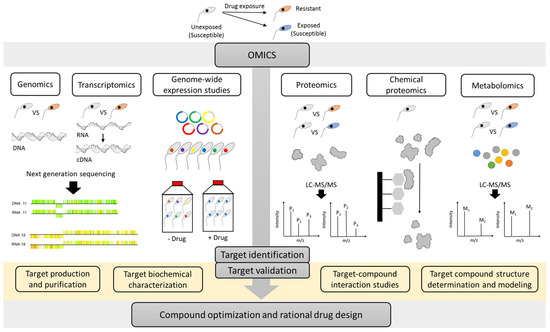1000/1000
Hot
Most Recent

Kinetoplastid parasites are responsible for high mortality and morbidity in (sub)tropical regions. In the development of new drugs, phenotypic screening already allowed the identification of promising new chemical entities with anti-kinetoplastid activity potential, but knowledge on their mode-of-action (MoA) is lacking due to the generally applied whole-cell based approach. However, identification of the drug target is highly beneficial to steer further hit finding, lead optimization and rational drug design. Multiple complementary ‘omics’ approaches have been successfully used to define the MoA or mode-of-resistance (MoR) of current reference drugs and some new anti-kinetoplastid compounds.
Kinetoplastids are the causative agents of leishmaniasis, human African trypanosomiasis, and American trypanosomiasis. They are responsible for high mortality and morbidity in (sub)tropical regions. Adequate treatment options are limited and have several drawbacks, such as toxicity, need for parenteral administration, and occurrence of treatment failure and drug resistance. Therefore, there is an urgency for the development of new drugs. Phenotypic screening already allowed the identification of promising new chemical entities with anti-kinetoplastid activity potential, but knowledge on their mode-of-action (MoA) is lacking due to the generally applied whole-cell based approach. However, identification of the drug target is essential to steer further drug discovery and development. Multiple complementary techniques have indeed been used for MoA elucidation.
Leishmaniasis, Chagas disease, and sleeping sickness are caused by kinetoplastid protozoan parasites and are responsible for high morbidity and mortality rates, especially in developing countries [1][2][3]. These diseases are characterized by severe clinical manifestations such as hepatosplenomegaly, cardiomyopathy, and neuropathology, all of which may lead to fatality if left untreated [4][5][6]. Current therapies are known to be less than adequate due to the suboptimal administration routes and long treatment duration, the occurrence of severe adverse effects, and the growing incidence of treatment failures [3][5][7]. It is evident that treatment options should be improved and that new drugs will be needed to sustain adequate disease control.
Target-based and phenotypic screening are two standard approaches adopted by the pharmaceutical industry to identify novel active chemical entities. So far, the former has not been very successful given the lack of fully validated targets and the limited knowledge on their molecular biology [3][4][8]. The few targets that have been suggested for Trypanosoma brucei and T. cruzi have only been partially characterized [8][9][10][11][12] and ornithine decarboxylase is currently the only fully validated target involved in the mode-of-action (MoA) of eflornithine [8][13]. Identification of novel drug ‘leads’ is generally still achieved by phenotypic cell-based screening [14][15][16][17] but with the disadvantage of lack of knowledge gained on the MoA. However, target elucidation remains pivotal for rational structure-based optimization of small molecules, which predicts adverse effects. Even though MoA studies are not essential for regulatory approval, they can strengthen successful drug development or redirect drug discovery [12][14][18][19][20]. Alternatively, knowledge on a drug’s mode-of-resistance (MoR) can also provide useful information for anti-kinetoplastid drug research [21].
As described in several reviews [18][19][22], multiple strategies can be used to identify the MoA of compounds. The present review specifically focuses on the different ‘omics’ approaches which in recent years have emerged as valuable techniques to evaluate the MoA and MoR of anti-kinetoplastid compounds (Figure 1).

Figure 1. An overview of the multiple omics strategies that can be used to unravel the target of an anti-kinetoplastid compounds. Resistant parasites can be experimentally selected in the laboratory or obtained from the field. Comparative genomics, transcriptomics, proteomics/metabolomics approaches, genome-wide cosmid/RNAi libraries, and chemical proteomics can contribute complementary insights in the mode-of-action (MoA) or mode-of-resistance (MoR). Application of the various omics methodologies can enable the identification of drug targets, which may serve as starting point for additional hit finding, lead optimization and rational drug design. M: metabolite and P: protein. A graphical item in the figure about next generation sequencing was adopted from another publication [23].